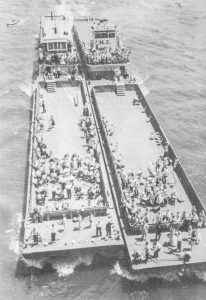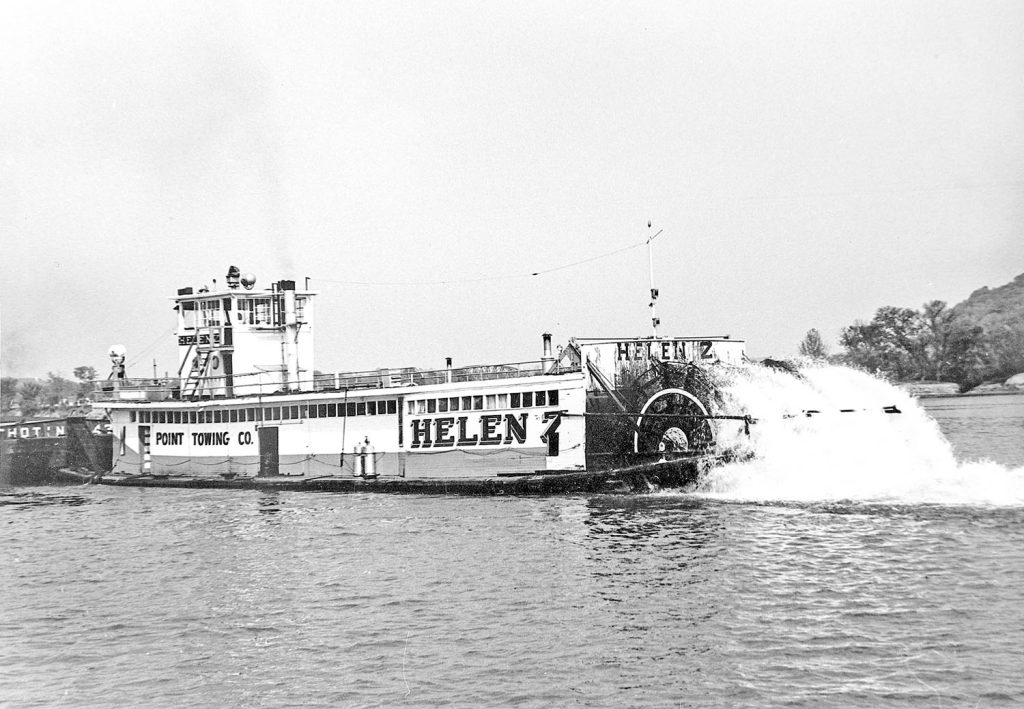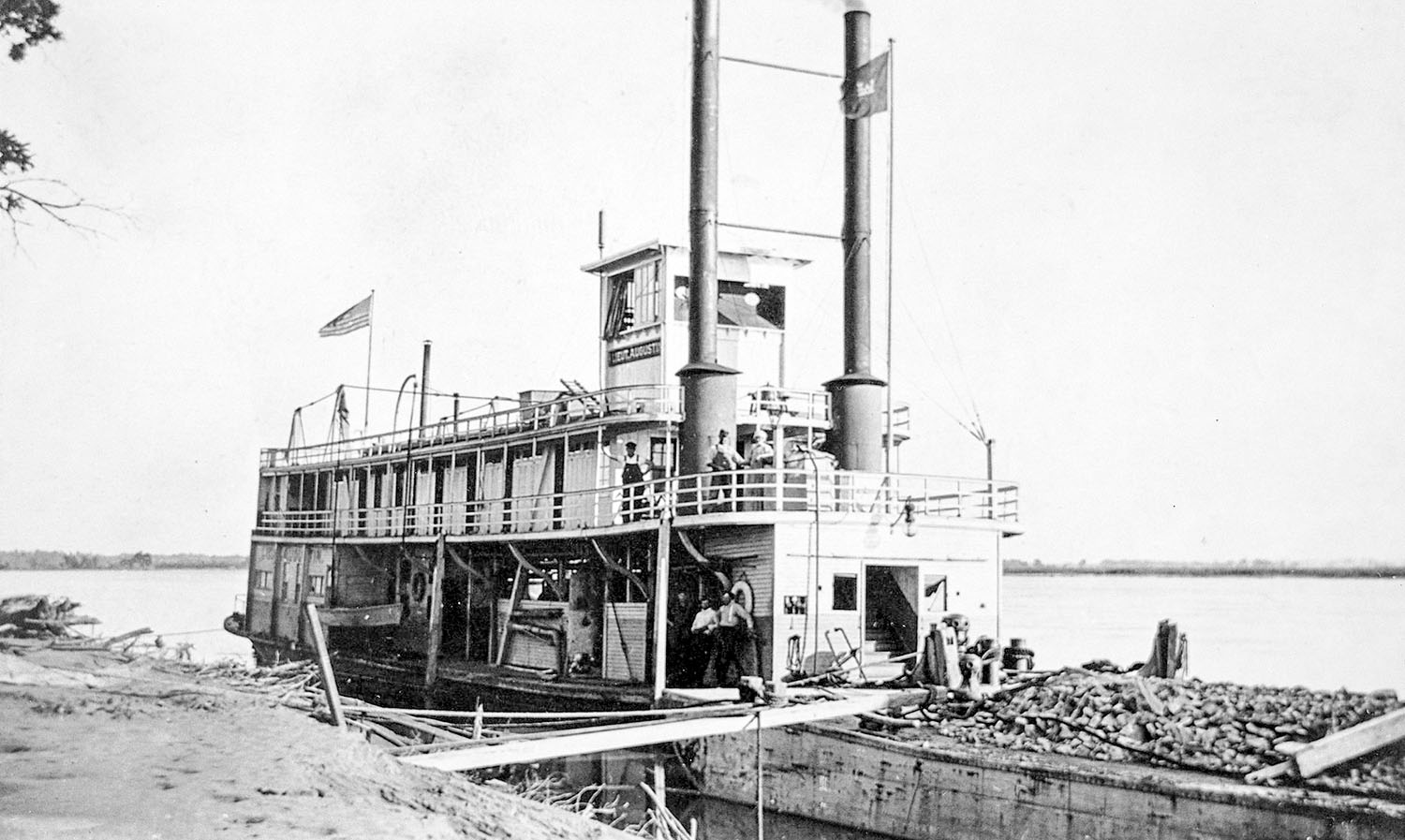Sixty years ago this past week, on June 23, 1963, a sternwheel towboat race was held at Charleston, W.Va., in conjunction with the centennial celebrations for the state of West Virginia. The two boats involved were the W.C. White (detailed in the July 11, 2022, issue of The Waterways Journal) and the Helen Z. The Helen Z has been mentioned in this column before by Keith Norrington, with photos showing the remains as it wound up in his back yard at New Albany, Ind.

The Helen Z began life as the steam towboat Lieut. Augustin, built by Dubuque Boat & Boiler Company for the U.S. Engineer Department in 1911. This was part of a series of boats Dubuque constructed for the Engineers in 1911-12, which also included the Lieut. Gurney, Lieut. Lewis, Augustus J. Nolty and W.M. Rees (WJ May 1, 2023). All were of sternwheel propulsion with condensing engines that were 13’s, 26’s – 5-foot stroke. The steel hulls measured 137.6 feet by 24 feet.
The Lieut. Augustin was first assigned to the Kansas City District of the Engineers, but it was later transferred to Memphis. In 1932, the hull was widened at Dravo, Neville Island, Pa. It may have been at this time that the cabin was also altered. As originally built, the boat had a full second deck cabin with a tall pilothouse situated on the roof, but later photos show the upper cabin severely shortened with a squat pilothouse placed above that. In May 1939, the boat was sold at a public sale to Charles Zubik, Pittsburgh.
Zubik rebuilt the Lieut. Augustin into a diesel vessel. As a diesel-powered boat, it had a split sternwheel with center drive powered by a 450 hp. Fairbanks-Morse engine and had a single cabin with a tall pilothouse. There was one smokestack situated behind the pilothouse. The diesel conversion by Zubik was very successful, and the vessel, now named Helen Z, had a reputation as being a strong shoving boat. Zubik later sold it to Hillman Transportation, who in turn sold it in 1953 to General Barge Company, Pittsburgh. In 1959 it was sold to Point Towing Company, Point Pleasant, W.Va., one of the companies owned by Capt. Robert H. Bosworth.
While owned by Point Towing, the Helen Z became a fixture on the Kanawha River, as well as the near reaches of the Ohio. Photos show it headed up the Kanawha with a string of three 300-foot tank barges and other large tows. The late Capt. Charles Henry Stone has told this writer that if he were on the 600 hp. Alan R. Merrill (WJ October 10, 2022) upbound on the Kanawha as far as Ten Mile (Mile 9.6) and heard the Helen Z on the radio entering the mouth of the river, he knew he would be caught by the 450 hp. sternwheeler before he got to Winfield Lock (Mile 31.1). I have been acquainted with several area rivermen, such as the late Capt. M.G. “Tom” Herdman of Buffalo, W.Va., who began their river careers aboard the Helen Z.
The Race
The race at Charleston came about as a part of the big centennial celebration for the state of West Virginia in 1963. The former steam sternwheel towboat Omar of The Ohio River Company had been recently retired and was remodeled into a showboat named Rhododendron that was towed along the navigable rivers throughout the state. The race held on June 23 was to be reminiscent of the races held a decade earlier between steamers of Armco Steel and Amherst Barge Company. Capt. Harry F. White was aboard his W.C. White, and Capt. Bob Bosworth was on the Helen Z as they raced at the capital city, each having one deck barge in tow.
In 1968, Capt. Bosworth sold his companies to M/G Transport Services Inc., Cincinnati. Representatives from M/G, interested in assembling a modern fleet of towboats, began divesting themselves of some of the older boats they had acquired, and the Helen Z was partially dismantled. The engine went to the Neales at Parkersburg, W.Va., who had purchased the Beaver from M/G that had a similar F-M engine. The remainder of the boat was donated to the New Albany, Ind., Jaycees for the princely sum of $1. The plan was to have the old boat on some short piers located on the riverfront that had once handled the tracks of the Southern Railway.

Due to many problems, the project was delayed, with the Helen Z languishing at the city boat launching ramp just above the Sherman Minton Bridge about Mile 608.5 on the Ohio River, where it had been moored. During the winter of 1969, the boat sank, and then in a spring flood the following year most of the wooden cabin, including the pilothouse, was carried away. Photos of the boat after the flood receded show the hull with a finely modeled bow caught up on the bank. The sponsons added by Dravo in 1932 are also readily apparent. The previously mentioned Capt. Tom Herdman said that he saw parts of the pilothouse lying in brush along the bank near old Lock 43, some 30 miles downstream. The forward part of the hull was removed, and then the rest was in evidence for some time until it was finally removed.
Note: In the last column on the Str. Sam Craig I failed to say that the Capt. Bert Shearer mentioned was the father of marine architect Ed Shearer.




